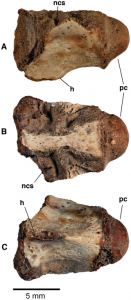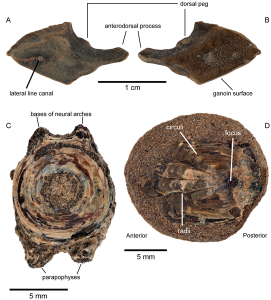Discovery of Eocene non-marine vertebrates, including crocodylians, turtles, bony fishes, and mammals in Canada’s High Arctic was a critical paleontological contribution of the last century because it indicated that this region of the Arctic had been mild, temperate, and ice-free during the early – middle Eocene (~53–50 Ma), despite being well above the Arctic Circle. To date, these discoveries have been restricted to Canada’s easternmost Arctic – Ellesmere and Axel Heiberg Islands (Nunavut). Although temporally correlative strata crop out over 1,000 km west, on Canada’s westernmost Arctic Island – Banks Island, Northwest Territories – they have been interpreted as predominantly marine. We document the first Eocene bony fish and crocodyliform fossils from Banks Island.
Principal Findings
We describe fossils of bony fishes, including lepisosteid (Atractosteus), esocid (pike), and amiid, and a crocodyliform, from lower – middle Eocene strata of the Cyclic Member, Eureka Sound Formation within Aulavik National Park (~76°N. paleolat.). Palynology suggests the sediments are late early to middle Eocene in age, and likely spanned the Early Eocene Climatic Optimum (EECO).
Conclusions/Significance
These fossils extend the geographic range of Eocene Arctic lepisosteids, esocids, amiids, and crocodyliforms west by approximately 40° of longitude or ~1100 km. The low diversity bony fish fauna, at least at the family level, is essentially identical on Ellesmere and Banks Islands, suggesting a pan-High Arctic bony fish fauna of relatively basal groups around the margin of the Eocene Arctic Ocean. From a paleoclimatic perspective, presence of a crocodyliform, gar and amiid fishes on northern Banks provides further evidence that mild, year-round temperatures extended across the Canadian Arctic during early – middle Eocene time. Additionally, the Banks Island crocodyliform is consistent with the phylogenetic hypothesis of a Paleogene divergence time between the two extant alligatorid lineages Alligator mississippiensis and A. sinensis, and high-latitude dispersal across Beringia.
Citation: Eberle JJ, Gottfried MD, Hutchison JH, Brochu CA (2014) First Record of Eocene Bony Fishes and Crocodyliforms from Canada’s Western Arctic. PLoS ONE 9(5): e96079. doi:10.1371/journal.pone.0096079
Editor: Peter Dodson, University of Pennsylvania, United States of America

CMNFV 56059, vertebral centrum of an Eocene crocodyliform from CMN Loc. BKS04-19 on northern Banks Island, NWT.
(A) Left lateral view; (B) dorsal view; (C) ventral view. h, hypapophysis; ncs, neurocentral sutural surface; pc, posterior cotyle. Scale bar equals 5 mm.
doi:10.1371/journal.pone.0096079.g003

Fossils of Eocene bony fishes from northern Banks Island, NWT.
CMNFV 56070, lateral line scale of Atractosteus from CMN Loc. BKS04-16, in medial (A) and lateral (B) views. (C) CMNFV 56069, vertebral centrum of ?Amiid. (D) CMNFV 56071, Esocid scale. C and D are from CMN Loc. BKS04-19.
doi:10.1371/journal.pone.0096079.g002



 July 14th, 2014
July 14th, 2014  Riffin
Riffin  Posted in
Posted in  Tags:
Tags: 